Unilever Report: Organizational Structure and Environmental Factors
VerifiedAdded on 2023/01/09
|11
|3718
|48
Report
AI Summary
This report provides a detailed analysis of Unilever's organizational structure, encompassing various aspects such as the types and purposes of organizations (public, private, and voluntary), their legal structures, and the scope and size of different business types (micro, small, medium, and large). It examines the interrelationship between organizational functions, including human resources, marketing, finance, and research and development, highlighting the advantages and disadvantages of strong departmental relationships. The report also explores the impact of micro-businesses and analyzes the internal and external factors influencing Unilever, including political and economic considerations. Furthermore, it investigates the interrelationship between macro environments and their effect on the company's operations and performance, providing a comprehensive overview of Unilever's business environment.
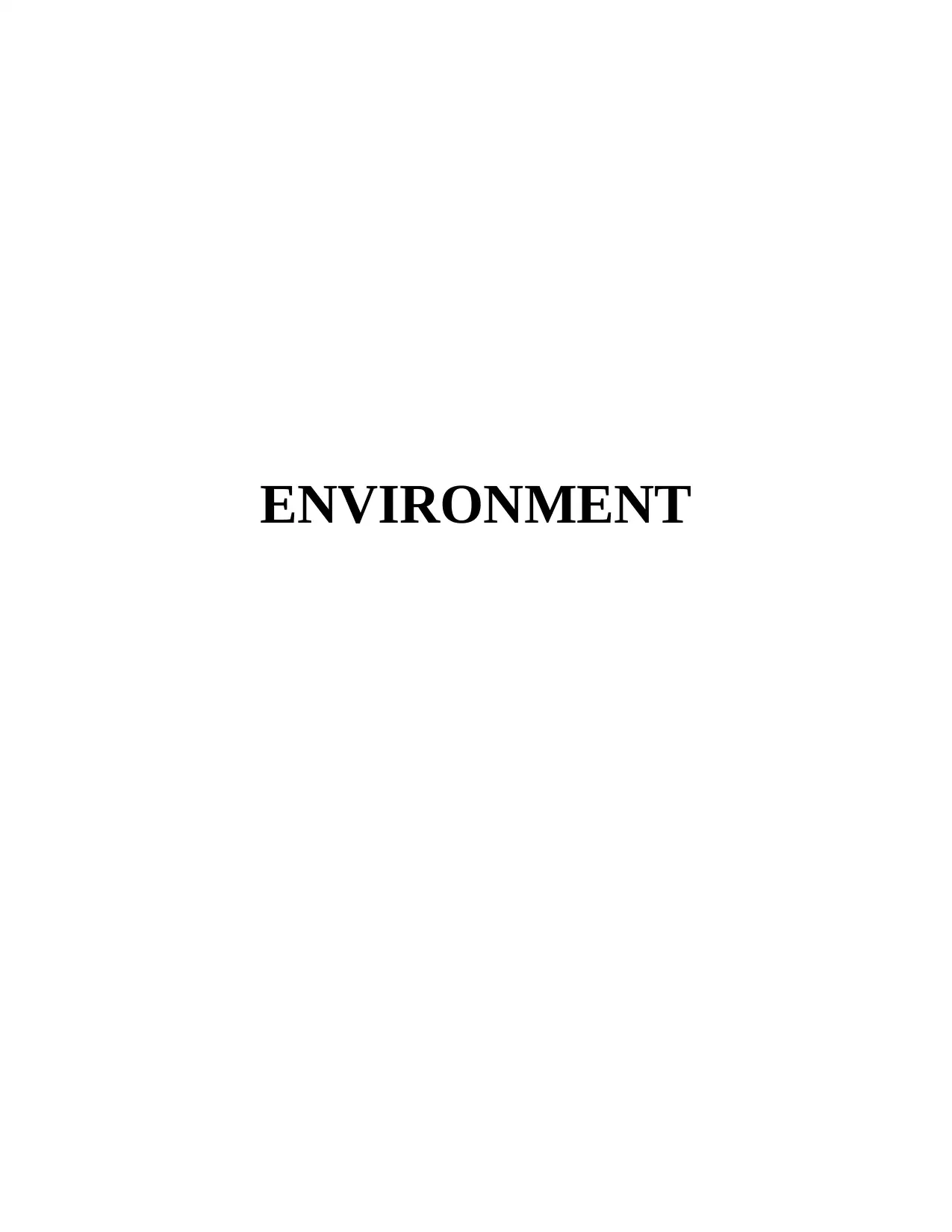
ENVIRONMENT
Paraphrase This Document
Need a fresh take? Get an instant paraphrase of this document with our AI Paraphraser
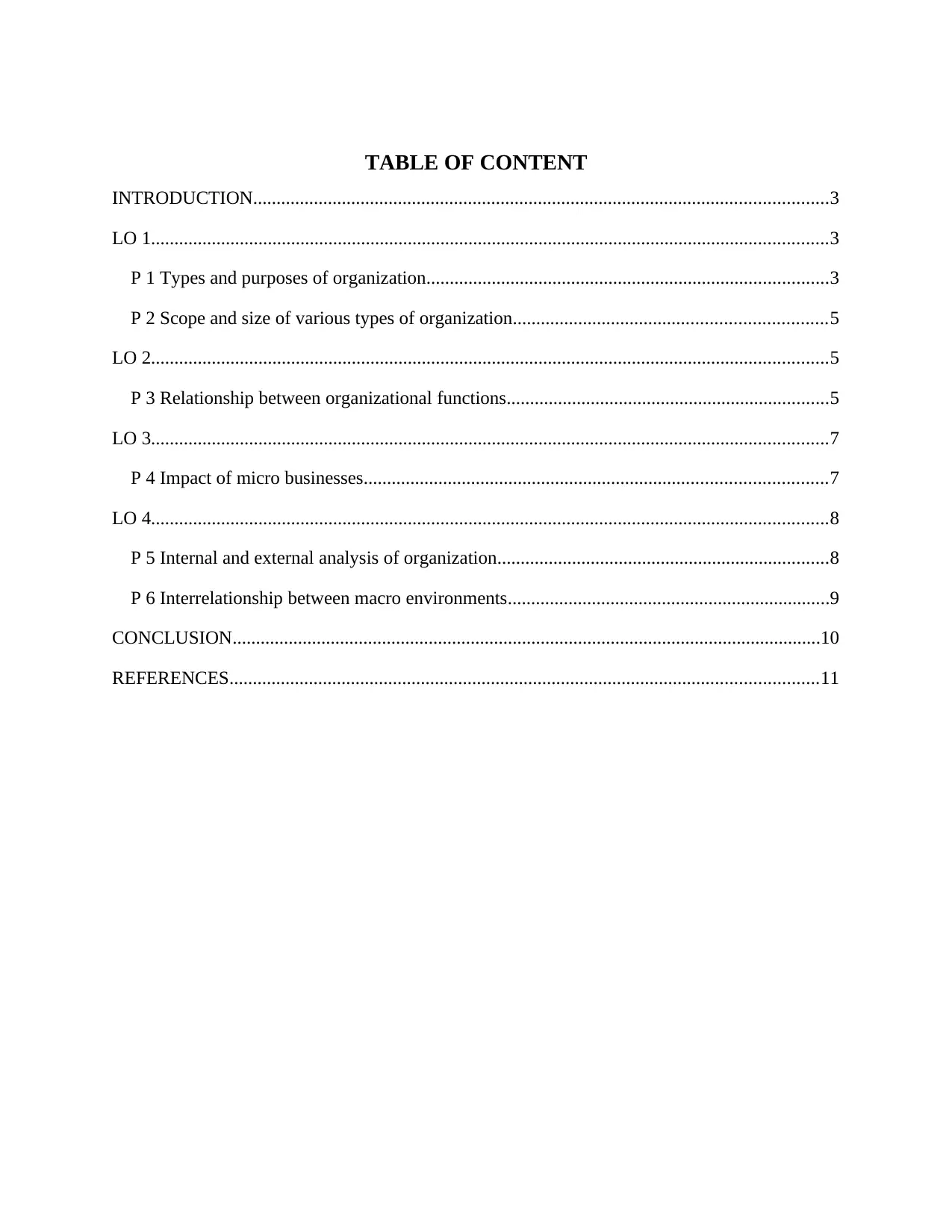
TABLE OF CONTENT
INTRODUCTION...........................................................................................................................3
LO 1.................................................................................................................................................3
P 1 Types and purposes of organization......................................................................................3
P 2 Scope and size of various types of organization...................................................................5
LO 2.................................................................................................................................................5
P 3 Relationship between organizational functions.....................................................................5
LO 3.................................................................................................................................................7
P 4 Impact of micro businesses...................................................................................................7
LO 4.................................................................................................................................................8
P 5 Internal and external analysis of organization.......................................................................8
P 6 Interrelationship between macro environments.....................................................................9
CONCLUSION..............................................................................................................................10
REFERENCES..............................................................................................................................11
INTRODUCTION...........................................................................................................................3
LO 1.................................................................................................................................................3
P 1 Types and purposes of organization......................................................................................3
P 2 Scope and size of various types of organization...................................................................5
LO 2.................................................................................................................................................5
P 3 Relationship between organizational functions.....................................................................5
LO 3.................................................................................................................................................7
P 4 Impact of micro businesses...................................................................................................7
LO 4.................................................................................................................................................8
P 5 Internal and external analysis of organization.......................................................................8
P 6 Interrelationship between macro environments.....................................................................9
CONCLUSION..............................................................................................................................10
REFERENCES..............................................................................................................................11
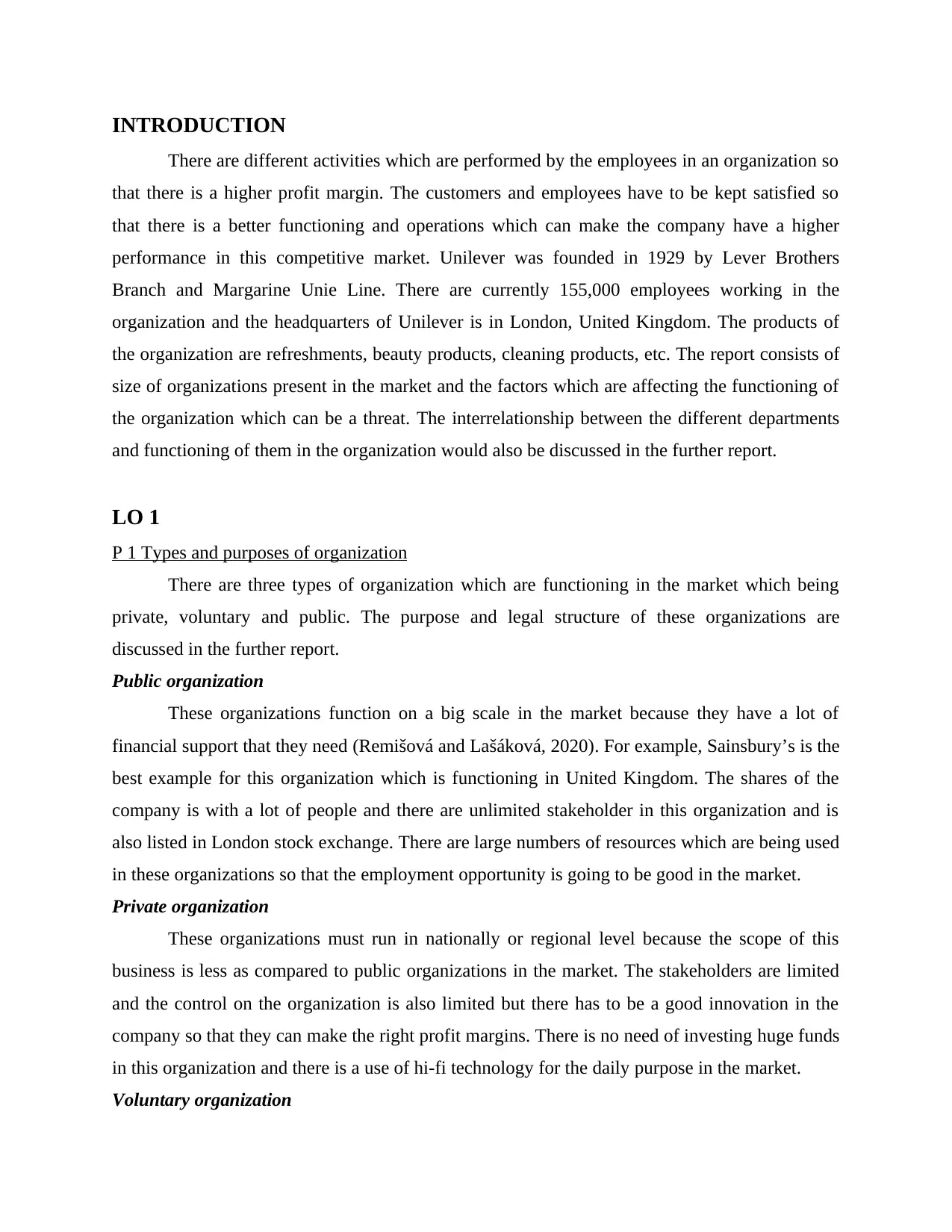
INTRODUCTION
There are different activities which are performed by the employees in an organization so
that there is a higher profit margin. The customers and employees have to be kept satisfied so
that there is a better functioning and operations which can make the company have a higher
performance in this competitive market. Unilever was founded in 1929 by Lever Brothers
Branch and Margarine Unie Line. There are currently 155,000 employees working in the
organization and the headquarters of Unilever is in London, United Kingdom. The products of
the organization are refreshments, beauty products, cleaning products, etc. The report consists of
size of organizations present in the market and the factors which are affecting the functioning of
the organization which can be a threat. The interrelationship between the different departments
and functioning of them in the organization would also be discussed in the further report.
LO 1
P 1 Types and purposes of organization
There are three types of organization which are functioning in the market which being
private, voluntary and public. The purpose and legal structure of these organizations are
discussed in the further report.
Public organization
These organizations function on a big scale in the market because they have a lot of
financial support that they need (Remišová and Lašáková, 2020). For example, Sainsbury’s is the
best example for this organization which is functioning in United Kingdom. The shares of the
company is with a lot of people and there are unlimited stakeholder in this organization and is
also listed in London stock exchange. There are large numbers of resources which are being used
in these organizations so that the employment opportunity is going to be good in the market.
Private organization
These organizations must run in nationally or regional level because the scope of this
business is less as compared to public organizations in the market. The stakeholders are limited
and the control on the organization is also limited but there has to be a good innovation in the
company so that they can make the right profit margins. There is no need of investing huge funds
in this organization and there is a use of hi-fi technology for the daily purpose in the market.
Voluntary organization
There are different activities which are performed by the employees in an organization so
that there is a higher profit margin. The customers and employees have to be kept satisfied so
that there is a better functioning and operations which can make the company have a higher
performance in this competitive market. Unilever was founded in 1929 by Lever Brothers
Branch and Margarine Unie Line. There are currently 155,000 employees working in the
organization and the headquarters of Unilever is in London, United Kingdom. The products of
the organization are refreshments, beauty products, cleaning products, etc. The report consists of
size of organizations present in the market and the factors which are affecting the functioning of
the organization which can be a threat. The interrelationship between the different departments
and functioning of them in the organization would also be discussed in the further report.
LO 1
P 1 Types and purposes of organization
There are three types of organization which are functioning in the market which being
private, voluntary and public. The purpose and legal structure of these organizations are
discussed in the further report.
Public organization
These organizations function on a big scale in the market because they have a lot of
financial support that they need (Remišová and Lašáková, 2020). For example, Sainsbury’s is the
best example for this organization which is functioning in United Kingdom. The shares of the
company is with a lot of people and there are unlimited stakeholder in this organization and is
also listed in London stock exchange. There are large numbers of resources which are being used
in these organizations so that the employment opportunity is going to be good in the market.
Private organization
These organizations must run in nationally or regional level because the scope of this
business is less as compared to public organizations in the market. The stakeholders are limited
and the control on the organization is also limited but there has to be a good innovation in the
company so that they can make the right profit margins. There is no need of investing huge funds
in this organization and there is a use of hi-fi technology for the daily purpose in the market.
Voluntary organization
⊘ This is a preview!⊘
Do you want full access?
Subscribe today to unlock all pages.

Trusted by 1+ million students worldwide
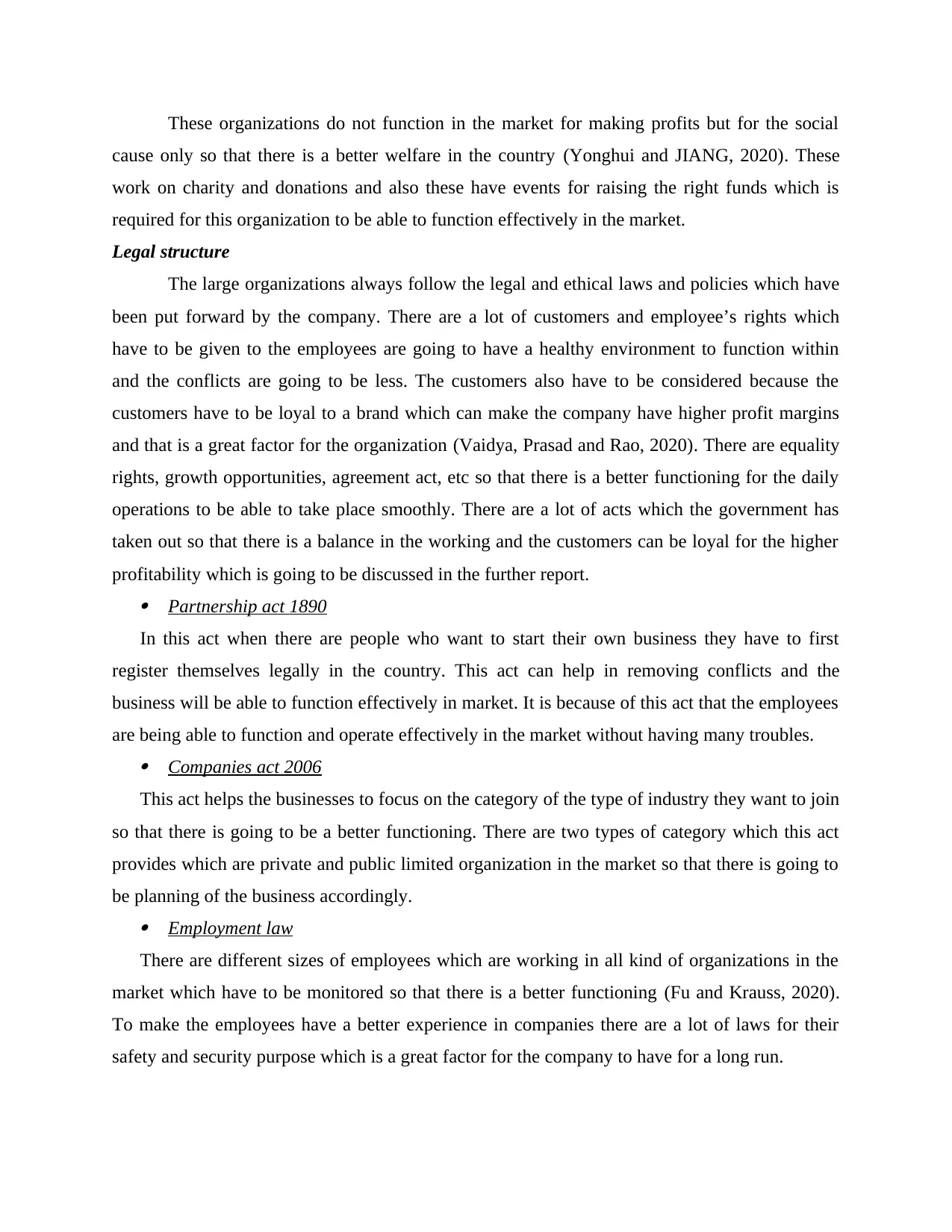
These organizations do not function in the market for making profits but for the social
cause only so that there is a better welfare in the country (Yonghui and JIANG, 2020). These
work on charity and donations and also these have events for raising the right funds which is
required for this organization to be able to function effectively in the market.
Legal structure
The large organizations always follow the legal and ethical laws and policies which have
been put forward by the company. There are a lot of customers and employee’s rights which
have to be given to the employees are going to have a healthy environment to function within
and the conflicts are going to be less. The customers also have to be considered because the
customers have to be loyal to a brand which can make the company have higher profit margins
and that is a great factor for the organization (Vaidya, Prasad and Rao, 2020). There are equality
rights, growth opportunities, agreement act, etc so that there is a better functioning for the daily
operations to be able to take place smoothly. There are a lot of acts which the government has
taken out so that there is a balance in the working and the customers can be loyal for the higher
profitability which is going to be discussed in the further report. Partnership act 1890
In this act when there are people who want to start their own business they have to first
register themselves legally in the country. This act can help in removing conflicts and the
business will be able to function effectively in market. It is because of this act that the employees
are being able to function and operate effectively in the market without having many troubles. Companies act 2006
This act helps the businesses to focus on the category of the type of industry they want to join
so that there is going to be a better functioning. There are two types of category which this act
provides which are private and public limited organization in the market so that there is going to
be planning of the business accordingly. Employment law
There are different sizes of employees which are working in all kind of organizations in the
market which have to be monitored so that there is a better functioning (Fu and Krauss, 2020).
To make the employees have a better experience in companies there are a lot of laws for their
safety and security purpose which is a great factor for the company to have for a long run.
cause only so that there is a better welfare in the country (Yonghui and JIANG, 2020). These
work on charity and donations and also these have events for raising the right funds which is
required for this organization to be able to function effectively in the market.
Legal structure
The large organizations always follow the legal and ethical laws and policies which have
been put forward by the company. There are a lot of customers and employee’s rights which
have to be given to the employees are going to have a healthy environment to function within
and the conflicts are going to be less. The customers also have to be considered because the
customers have to be loyal to a brand which can make the company have higher profit margins
and that is a great factor for the organization (Vaidya, Prasad and Rao, 2020). There are equality
rights, growth opportunities, agreement act, etc so that there is a better functioning for the daily
operations to be able to take place smoothly. There are a lot of acts which the government has
taken out so that there is a balance in the working and the customers can be loyal for the higher
profitability which is going to be discussed in the further report. Partnership act 1890
In this act when there are people who want to start their own business they have to first
register themselves legally in the country. This act can help in removing conflicts and the
business will be able to function effectively in market. It is because of this act that the employees
are being able to function and operate effectively in the market without having many troubles. Companies act 2006
This act helps the businesses to focus on the category of the type of industry they want to join
so that there is going to be a better functioning. There are two types of category which this act
provides which are private and public limited organization in the market so that there is going to
be planning of the business accordingly. Employment law
There are different sizes of employees which are working in all kind of organizations in the
market which have to be monitored so that there is a better functioning (Fu and Krauss, 2020).
To make the employees have a better experience in companies there are a lot of laws for their
safety and security purpose which is a great factor for the company to have for a long run.
Paraphrase This Document
Need a fresh take? Get an instant paraphrase of this document with our AI Paraphraser
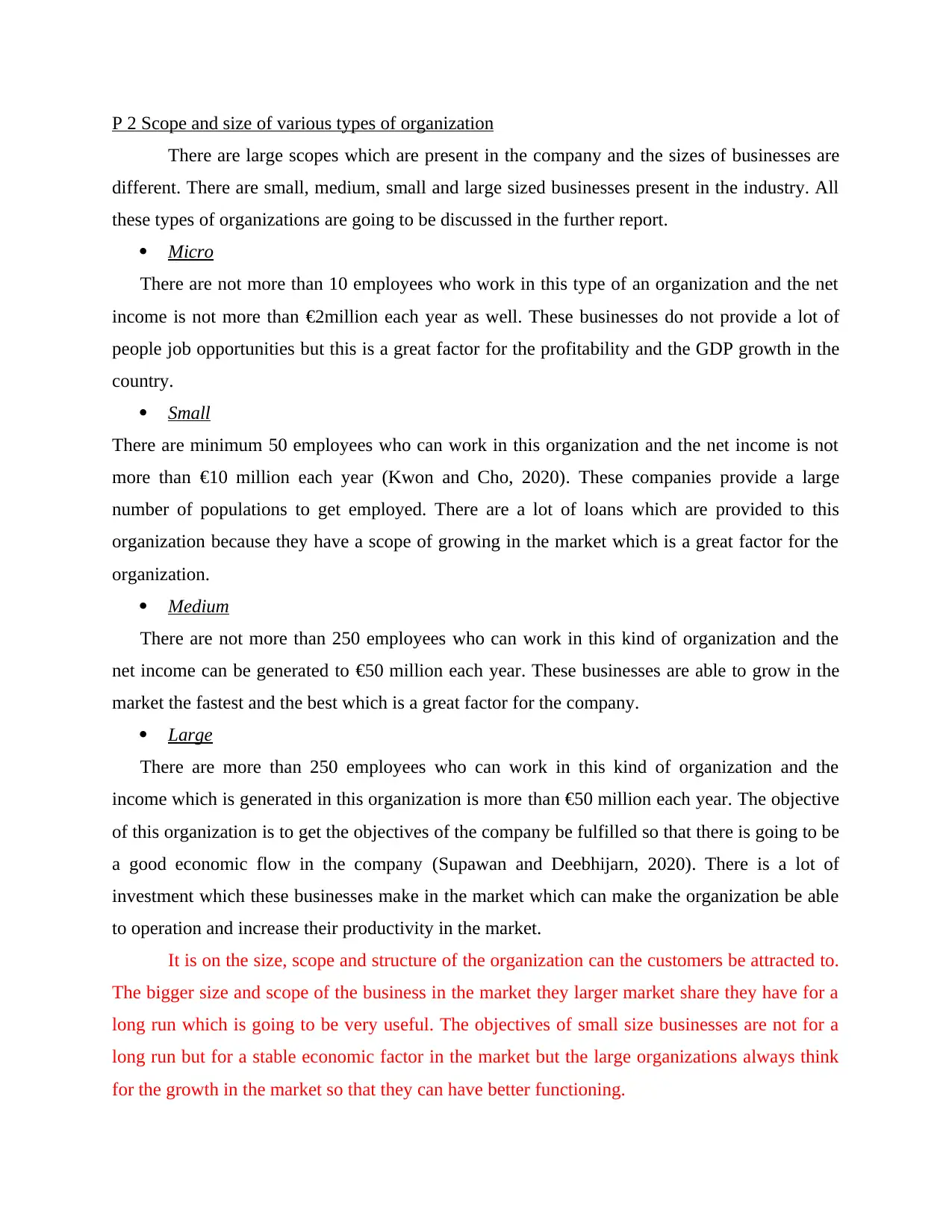
P 2 Scope and size of various types of organization
There are large scopes which are present in the company and the sizes of businesses are
different. There are small, medium, small and large sized businesses present in the industry. All
these types of organizations are going to be discussed in the further report.
Micro
There are not more than 10 employees who work in this type of an organization and the net
income is not more than €2million each year as well. These businesses do not provide a lot of
people job opportunities but this is a great factor for the profitability and the GDP growth in the
country.
Small
There are minimum 50 employees who can work in this organization and the net income is not
more than €10 million each year (Kwon and Cho, 2020). These companies provide a large
number of populations to get employed. There are a lot of loans which are provided to this
organization because they have a scope of growing in the market which is a great factor for the
organization.
Medium
There are not more than 250 employees who can work in this kind of organization and the
net income can be generated to €50 million each year. These businesses are able to grow in the
market the fastest and the best which is a great factor for the company.
Large
There are more than 250 employees who can work in this kind of organization and the
income which is generated in this organization is more than €50 million each year. The objective
of this organization is to get the objectives of the company be fulfilled so that there is going to be
a good economic flow in the company (Supawan and Deebhijarn, 2020). There is a lot of
investment which these businesses make in the market which can make the organization be able
to operation and increase their productivity in the market.
It is on the size, scope and structure of the organization can the customers be attracted to.
The bigger size and scope of the business in the market they larger market share they have for a
long run which is going to be very useful. The objectives of small size businesses are not for a
long run but for a stable economic factor in the market but the large organizations always think
for the growth in the market so that they can have better functioning.
There are large scopes which are present in the company and the sizes of businesses are
different. There are small, medium, small and large sized businesses present in the industry. All
these types of organizations are going to be discussed in the further report.
Micro
There are not more than 10 employees who work in this type of an organization and the net
income is not more than €2million each year as well. These businesses do not provide a lot of
people job opportunities but this is a great factor for the profitability and the GDP growth in the
country.
Small
There are minimum 50 employees who can work in this organization and the net income is not
more than €10 million each year (Kwon and Cho, 2020). These companies provide a large
number of populations to get employed. There are a lot of loans which are provided to this
organization because they have a scope of growing in the market which is a great factor for the
organization.
Medium
There are not more than 250 employees who can work in this kind of organization and the
net income can be generated to €50 million each year. These businesses are able to grow in the
market the fastest and the best which is a great factor for the company.
Large
There are more than 250 employees who can work in this kind of organization and the
income which is generated in this organization is more than €50 million each year. The objective
of this organization is to get the objectives of the company be fulfilled so that there is going to be
a good economic flow in the company (Supawan and Deebhijarn, 2020). There is a lot of
investment which these businesses make in the market which can make the organization be able
to operation and increase their productivity in the market.
It is on the size, scope and structure of the organization can the customers be attracted to.
The bigger size and scope of the business in the market they larger market share they have for a
long run which is going to be very useful. The objectives of small size businesses are not for a
long run but for a stable economic factor in the market but the large organizations always think
for the growth in the market so that they can have better functioning.
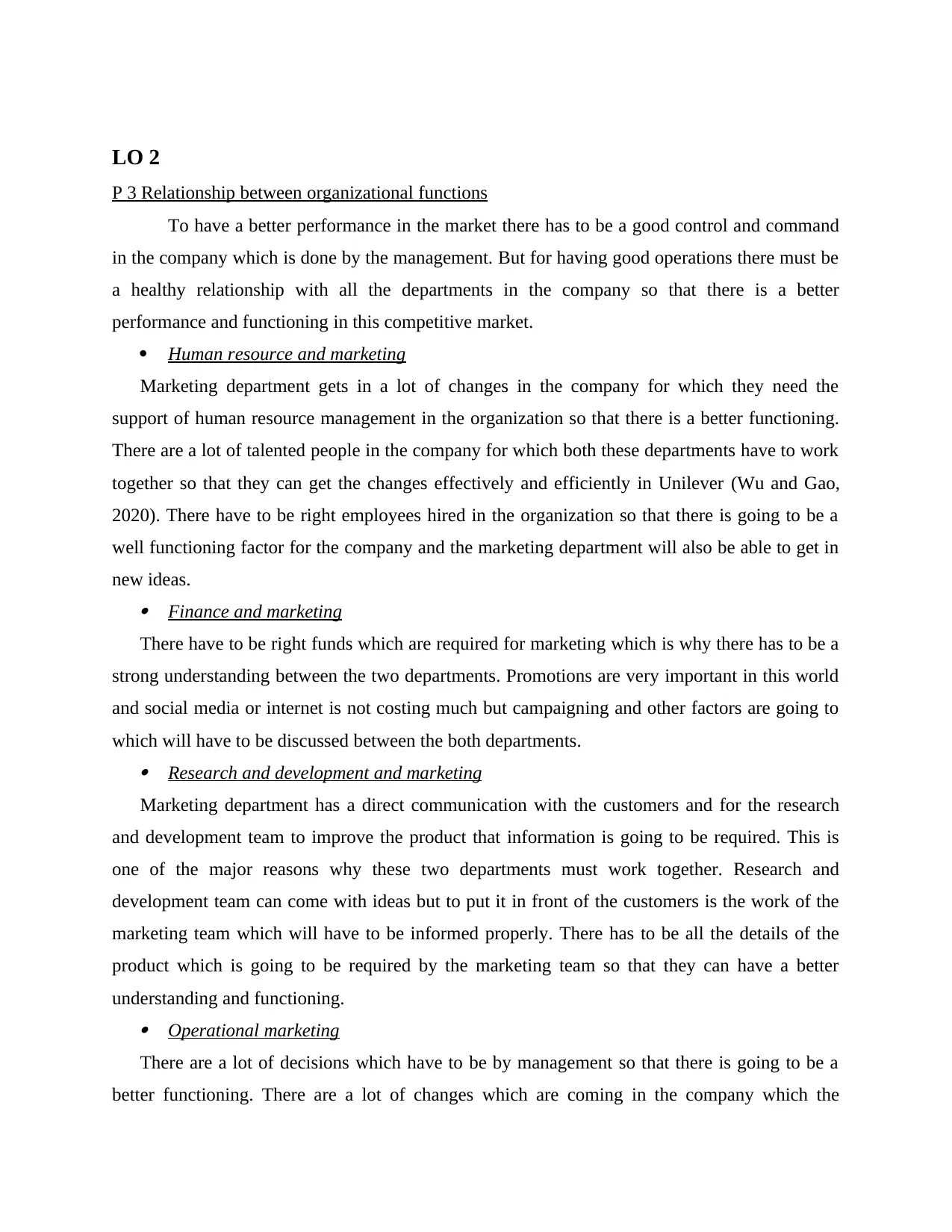
LO 2
P 3 Relationship between organizational functions
To have a better performance in the market there has to be a good control and command
in the company which is done by the management. But for having good operations there must be
a healthy relationship with all the departments in the company so that there is a better
performance and functioning in this competitive market.
Human resource and marketing
Marketing department gets in a lot of changes in the company for which they need the
support of human resource management in the organization so that there is a better functioning.
There are a lot of talented people in the company for which both these departments have to work
together so that they can get the changes effectively and efficiently in Unilever (Wu and Gao,
2020). There have to be right employees hired in the organization so that there is going to be a
well functioning factor for the company and the marketing department will also be able to get in
new ideas. Finance and marketing
There have to be right funds which are required for marketing which is why there has to be a
strong understanding between the two departments. Promotions are very important in this world
and social media or internet is not costing much but campaigning and other factors are going to
which will have to be discussed between the both departments. Research and development and marketing
Marketing department has a direct communication with the customers and for the research
and development team to improve the product that information is going to be required. This is
one of the major reasons why these two departments must work together. Research and
development team can come with ideas but to put it in front of the customers is the work of the
marketing team which will have to be informed properly. There has to be all the details of the
product which is going to be required by the marketing team so that they can have a better
understanding and functioning. Operational marketing
There are a lot of decisions which have to be by management so that there is going to be a
better functioning. There are a lot of changes which are coming in the company which the
P 3 Relationship between organizational functions
To have a better performance in the market there has to be a good control and command
in the company which is done by the management. But for having good operations there must be
a healthy relationship with all the departments in the company so that there is a better
performance and functioning in this competitive market.
Human resource and marketing
Marketing department gets in a lot of changes in the company for which they need the
support of human resource management in the organization so that there is a better functioning.
There are a lot of talented people in the company for which both these departments have to work
together so that they can get the changes effectively and efficiently in Unilever (Wu and Gao,
2020). There have to be right employees hired in the organization so that there is going to be a
well functioning factor for the company and the marketing department will also be able to get in
new ideas. Finance and marketing
There have to be right funds which are required for marketing which is why there has to be a
strong understanding between the two departments. Promotions are very important in this world
and social media or internet is not costing much but campaigning and other factors are going to
which will have to be discussed between the both departments. Research and development and marketing
Marketing department has a direct communication with the customers and for the research
and development team to improve the product that information is going to be required. This is
one of the major reasons why these two departments must work together. Research and
development team can come with ideas but to put it in front of the customers is the work of the
marketing team which will have to be informed properly. There has to be all the details of the
product which is going to be required by the marketing team so that they can have a better
understanding and functioning. Operational marketing
There are a lot of decisions which have to be by management so that there is going to be a
better functioning. There are a lot of changes which are coming in the company which the
⊘ This is a preview!⊘
Do you want full access?
Subscribe today to unlock all pages.

Trusted by 1+ million students worldwide
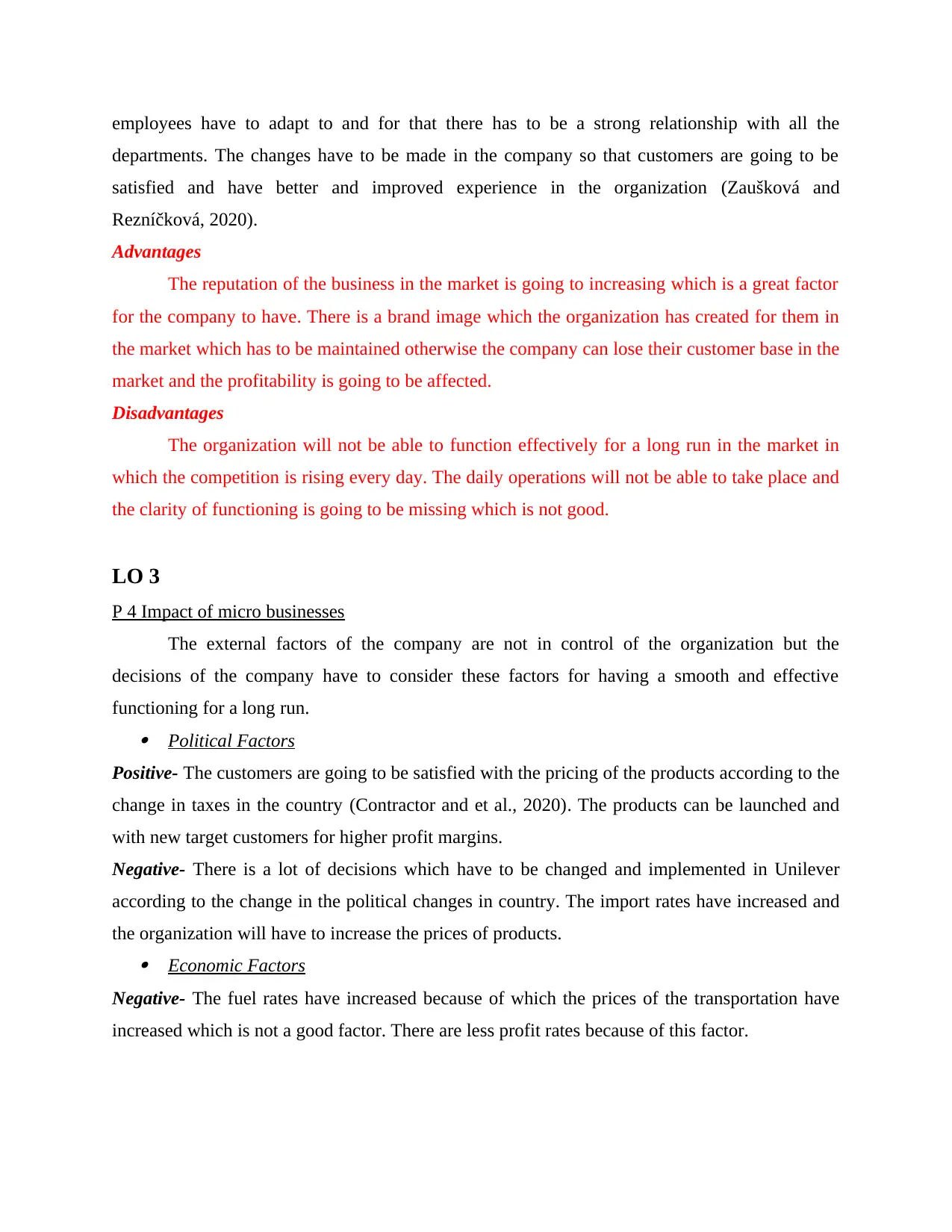
employees have to adapt to and for that there has to be a strong relationship with all the
departments. The changes have to be made in the company so that customers are going to be
satisfied and have better and improved experience in the organization (Zaušková and
Rezníčková, 2020).
Advantages
The reputation of the business in the market is going to increasing which is a great factor
for the company to have. There is a brand image which the organization has created for them in
the market which has to be maintained otherwise the company can lose their customer base in the
market and the profitability is going to be affected.
Disadvantages
The organization will not be able to function effectively for a long run in the market in
which the competition is rising every day. The daily operations will not be able to take place and
the clarity of functioning is going to be missing which is not good.
LO 3
P 4 Impact of micro businesses
The external factors of the company are not in control of the organization but the
decisions of the company have to consider these factors for having a smooth and effective
functioning for a long run. Political Factors
Positive- The customers are going to be satisfied with the pricing of the products according to the
change in taxes in the country (Contractor and et al., 2020). The products can be launched and
with new target customers for higher profit margins.
Negative- There is a lot of decisions which have to be changed and implemented in Unilever
according to the change in the political changes in country. The import rates have increased and
the organization will have to increase the prices of products. Economic Factors
Negative- The fuel rates have increased because of which the prices of the transportation have
increased which is not a good factor. There are less profit rates because of this factor.
departments. The changes have to be made in the company so that customers are going to be
satisfied and have better and improved experience in the organization (Zaušková and
Rezníčková, 2020).
Advantages
The reputation of the business in the market is going to increasing which is a great factor
for the company to have. There is a brand image which the organization has created for them in
the market which has to be maintained otherwise the company can lose their customer base in the
market and the profitability is going to be affected.
Disadvantages
The organization will not be able to function effectively for a long run in the market in
which the competition is rising every day. The daily operations will not be able to take place and
the clarity of functioning is going to be missing which is not good.
LO 3
P 4 Impact of micro businesses
The external factors of the company are not in control of the organization but the
decisions of the company have to consider these factors for having a smooth and effective
functioning for a long run. Political Factors
Positive- The customers are going to be satisfied with the pricing of the products according to the
change in taxes in the country (Contractor and et al., 2020). The products can be launched and
with new target customers for higher profit margins.
Negative- There is a lot of decisions which have to be changed and implemented in Unilever
according to the change in the political changes in country. The import rates have increased and
the organization will have to increase the prices of products. Economic Factors
Negative- The fuel rates have increased because of which the prices of the transportation have
increased which is not a good factor. There are less profit rates because of this factor.
Paraphrase This Document
Need a fresh take? Get an instant paraphrase of this document with our AI Paraphraser
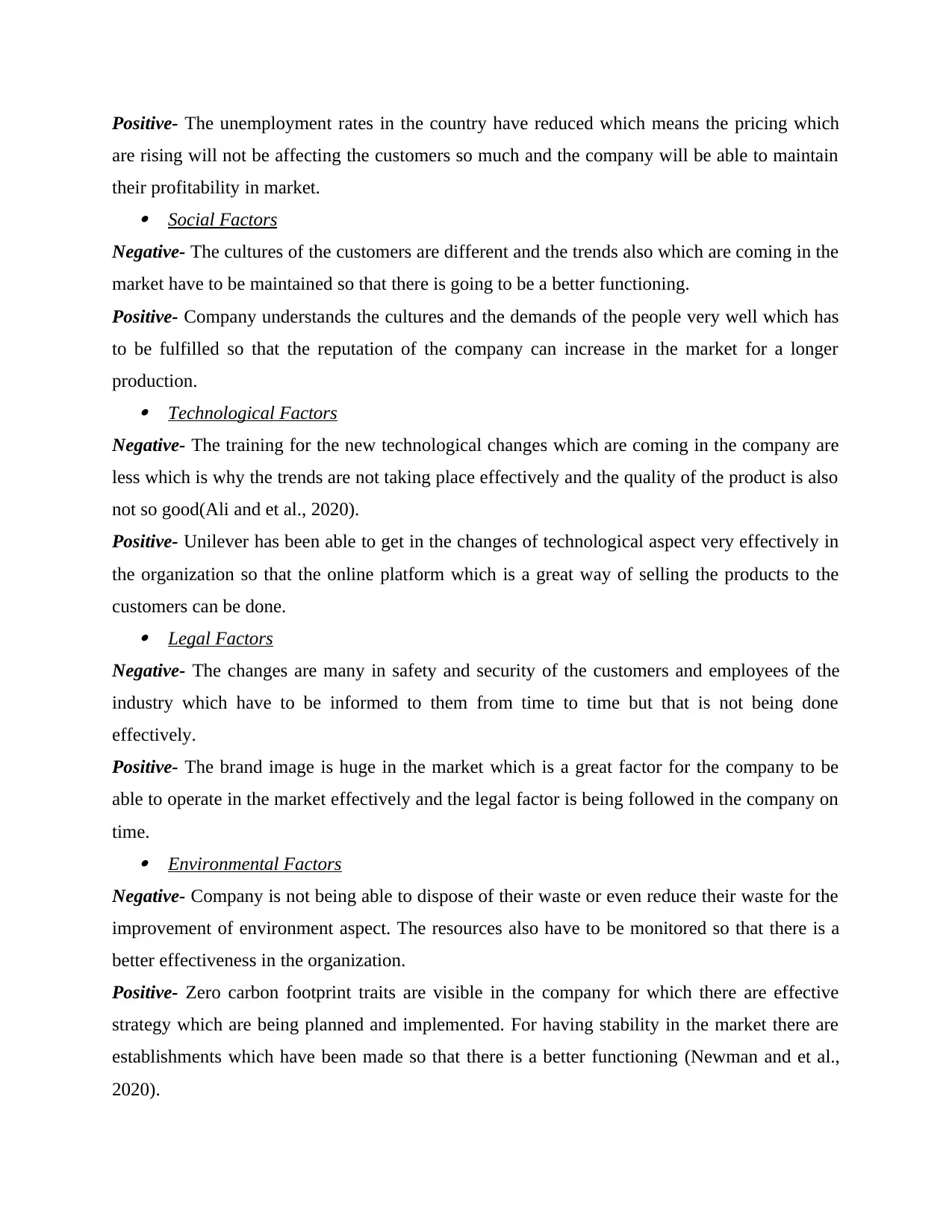
Positive- The unemployment rates in the country have reduced which means the pricing which
are rising will not be affecting the customers so much and the company will be able to maintain
their profitability in market. Social Factors
Negative- The cultures of the customers are different and the trends also which are coming in the
market have to be maintained so that there is going to be a better functioning.
Positive- Company understands the cultures and the demands of the people very well which has
to be fulfilled so that the reputation of the company can increase in the market for a longer
production. Technological Factors
Negative- The training for the new technological changes which are coming in the company are
less which is why the trends are not taking place effectively and the quality of the product is also
not so good(Ali and et al., 2020).
Positive- Unilever has been able to get in the changes of technological aspect very effectively in
the organization so that the online platform which is a great way of selling the products to the
customers can be done. Legal Factors
Negative- The changes are many in safety and security of the customers and employees of the
industry which have to be informed to them from time to time but that is not being done
effectively.
Positive- The brand image is huge in the market which is a great factor for the company to be
able to operate in the market effectively and the legal factor is being followed in the company on
time. Environmental Factors
Negative- Company is not being able to dispose of their waste or even reduce their waste for the
improvement of environment aspect. The resources also have to be monitored so that there is a
better effectiveness in the organization.
Positive- Zero carbon footprint traits are visible in the company for which there are effective
strategy which are being planned and implemented. For having stability in the market there are
establishments which have been made so that there is a better functioning (Newman and et al.,
2020).
are rising will not be affecting the customers so much and the company will be able to maintain
their profitability in market. Social Factors
Negative- The cultures of the customers are different and the trends also which are coming in the
market have to be maintained so that there is going to be a better functioning.
Positive- Company understands the cultures and the demands of the people very well which has
to be fulfilled so that the reputation of the company can increase in the market for a longer
production. Technological Factors
Negative- The training for the new technological changes which are coming in the company are
less which is why the trends are not taking place effectively and the quality of the product is also
not so good(Ali and et al., 2020).
Positive- Unilever has been able to get in the changes of technological aspect very effectively in
the organization so that the online platform which is a great way of selling the products to the
customers can be done. Legal Factors
Negative- The changes are many in safety and security of the customers and employees of the
industry which have to be informed to them from time to time but that is not being done
effectively.
Positive- The brand image is huge in the market which is a great factor for the company to be
able to operate in the market effectively and the legal factor is being followed in the company on
time. Environmental Factors
Negative- Company is not being able to dispose of their waste or even reduce their waste for the
improvement of environment aspect. The resources also have to be monitored so that there is a
better effectiveness in the organization.
Positive- Zero carbon footprint traits are visible in the company for which there are effective
strategy which are being planned and implemented. For having stability in the market there are
establishments which have been made so that there is a better functioning (Newman and et al.,
2020).
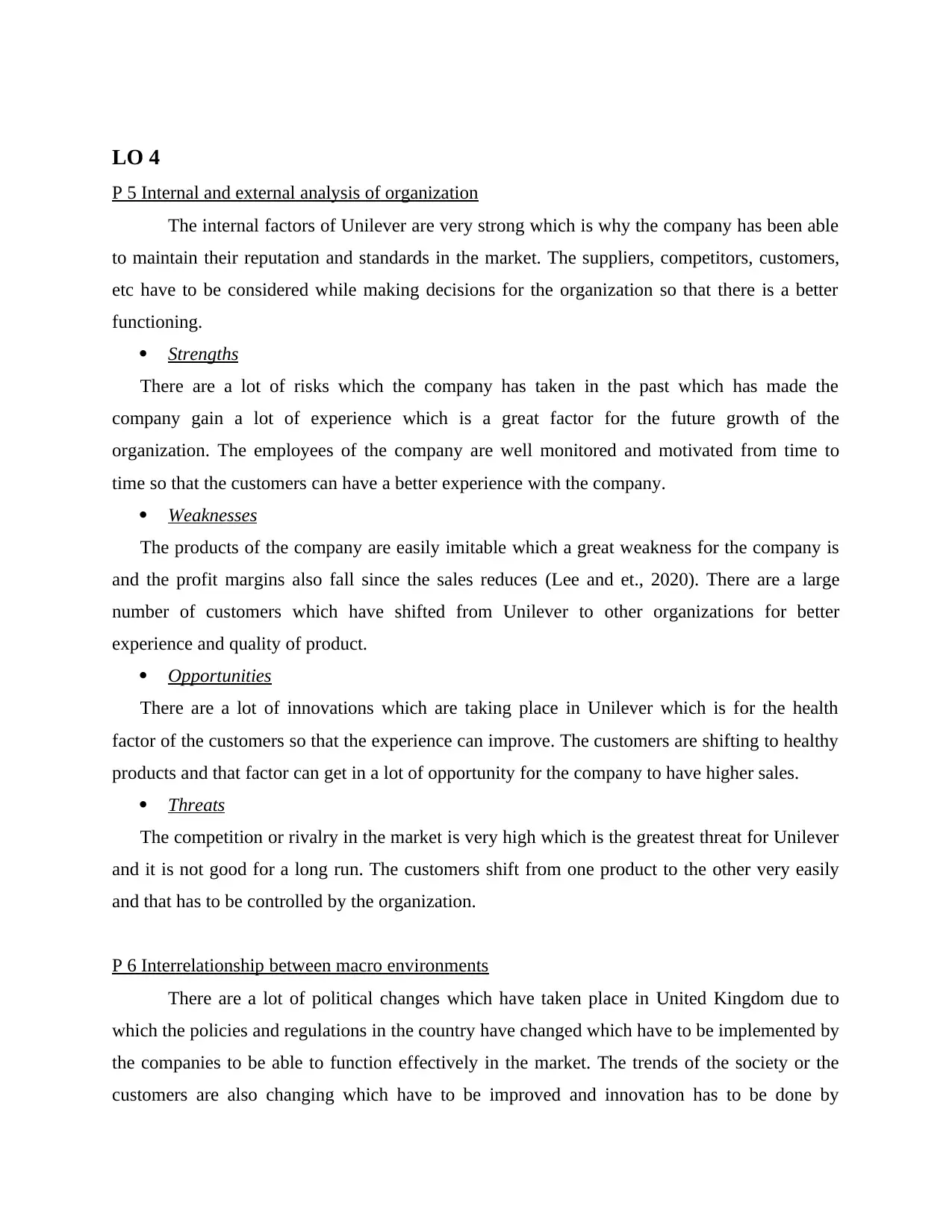
LO 4
P 5 Internal and external analysis of organization
The internal factors of Unilever are very strong which is why the company has been able
to maintain their reputation and standards in the market. The suppliers, competitors, customers,
etc have to be considered while making decisions for the organization so that there is a better
functioning.
Strengths
There are a lot of risks which the company has taken in the past which has made the
company gain a lot of experience which is a great factor for the future growth of the
organization. The employees of the company are well monitored and motivated from time to
time so that the customers can have a better experience with the company.
Weaknesses
The products of the company are easily imitable which a great weakness for the company is
and the profit margins also fall since the sales reduces (Lee and et., 2020). There are a large
number of customers which have shifted from Unilever to other organizations for better
experience and quality of product.
Opportunities
There are a lot of innovations which are taking place in Unilever which is for the health
factor of the customers so that the experience can improve. The customers are shifting to healthy
products and that factor can get in a lot of opportunity for the company to have higher sales.
Threats
The competition or rivalry in the market is very high which is the greatest threat for Unilever
and it is not good for a long run. The customers shift from one product to the other very easily
and that has to be controlled by the organization.
P 6 Interrelationship between macro environments
There are a lot of political changes which have taken place in United Kingdom due to
which the policies and regulations in the country have changed which have to be implemented by
the companies to be able to function effectively in the market. The trends of the society or the
customers are also changing which have to be improved and innovation has to be done by
P 5 Internal and external analysis of organization
The internal factors of Unilever are very strong which is why the company has been able
to maintain their reputation and standards in the market. The suppliers, competitors, customers,
etc have to be considered while making decisions for the organization so that there is a better
functioning.
Strengths
There are a lot of risks which the company has taken in the past which has made the
company gain a lot of experience which is a great factor for the future growth of the
organization. The employees of the company are well monitored and motivated from time to
time so that the customers can have a better experience with the company.
Weaknesses
The products of the company are easily imitable which a great weakness for the company is
and the profit margins also fall since the sales reduces (Lee and et., 2020). There are a large
number of customers which have shifted from Unilever to other organizations for better
experience and quality of product.
Opportunities
There are a lot of innovations which are taking place in Unilever which is for the health
factor of the customers so that the experience can improve. The customers are shifting to healthy
products and that factor can get in a lot of opportunity for the company to have higher sales.
Threats
The competition or rivalry in the market is very high which is the greatest threat for Unilever
and it is not good for a long run. The customers shift from one product to the other very easily
and that has to be controlled by the organization.
P 6 Interrelationship between macro environments
There are a lot of political changes which have taken place in United Kingdom due to
which the policies and regulations in the country have changed which have to be implemented by
the companies to be able to function effectively in the market. The trends of the society or the
customers are also changing which have to be improved and innovation has to be done by
⊘ This is a preview!⊘
Do you want full access?
Subscribe today to unlock all pages.

Trusted by 1+ million students worldwide
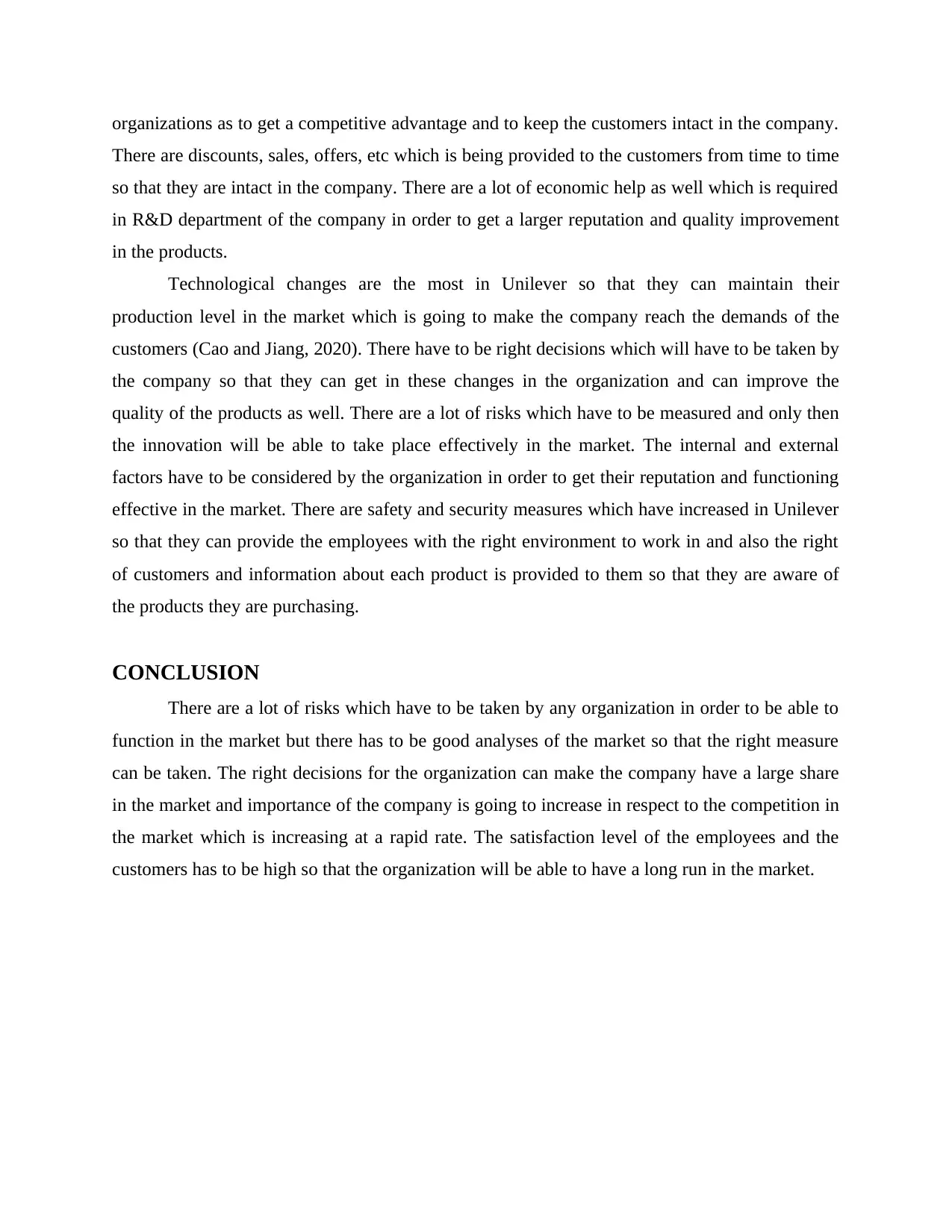
organizations as to get a competitive advantage and to keep the customers intact in the company.
There are discounts, sales, offers, etc which is being provided to the customers from time to time
so that they are intact in the company. There are a lot of economic help as well which is required
in R&D department of the company in order to get a larger reputation and quality improvement
in the products.
Technological changes are the most in Unilever so that they can maintain their
production level in the market which is going to make the company reach the demands of the
customers (Cao and Jiang, 2020). There have to be right decisions which will have to be taken by
the company so that they can get in these changes in the organization and can improve the
quality of the products as well. There are a lot of risks which have to be measured and only then
the innovation will be able to take place effectively in the market. The internal and external
factors have to be considered by the organization in order to get their reputation and functioning
effective in the market. There are safety and security measures which have increased in Unilever
so that they can provide the employees with the right environment to work in and also the right
of customers and information about each product is provided to them so that they are aware of
the products they are purchasing.
CONCLUSION
There are a lot of risks which have to be taken by any organization in order to be able to
function in the market but there has to be good analyses of the market so that the right measure
can be taken. The right decisions for the organization can make the company have a large share
in the market and importance of the company is going to increase in respect to the competition in
the market which is increasing at a rapid rate. The satisfaction level of the employees and the
customers has to be high so that the organization will be able to have a long run in the market.
There are discounts, sales, offers, etc which is being provided to the customers from time to time
so that they are intact in the company. There are a lot of economic help as well which is required
in R&D department of the company in order to get a larger reputation and quality improvement
in the products.
Technological changes are the most in Unilever so that they can maintain their
production level in the market which is going to make the company reach the demands of the
customers (Cao and Jiang, 2020). There have to be right decisions which will have to be taken by
the company so that they can get in these changes in the organization and can improve the
quality of the products as well. There are a lot of risks which have to be measured and only then
the innovation will be able to take place effectively in the market. The internal and external
factors have to be considered by the organization in order to get their reputation and functioning
effective in the market. There are safety and security measures which have increased in Unilever
so that they can provide the employees with the right environment to work in and also the right
of customers and information about each product is provided to them so that they are aware of
the products they are purchasing.
CONCLUSION
There are a lot of risks which have to be taken by any organization in order to be able to
function in the market but there has to be good analyses of the market so that the right measure
can be taken. The right decisions for the organization can make the company have a large share
in the market and importance of the company is going to increase in respect to the competition in
the market which is increasing at a rapid rate. The satisfaction level of the employees and the
customers has to be high so that the organization will be able to have a long run in the market.
Paraphrase This Document
Need a fresh take? Get an instant paraphrase of this document with our AI Paraphraser
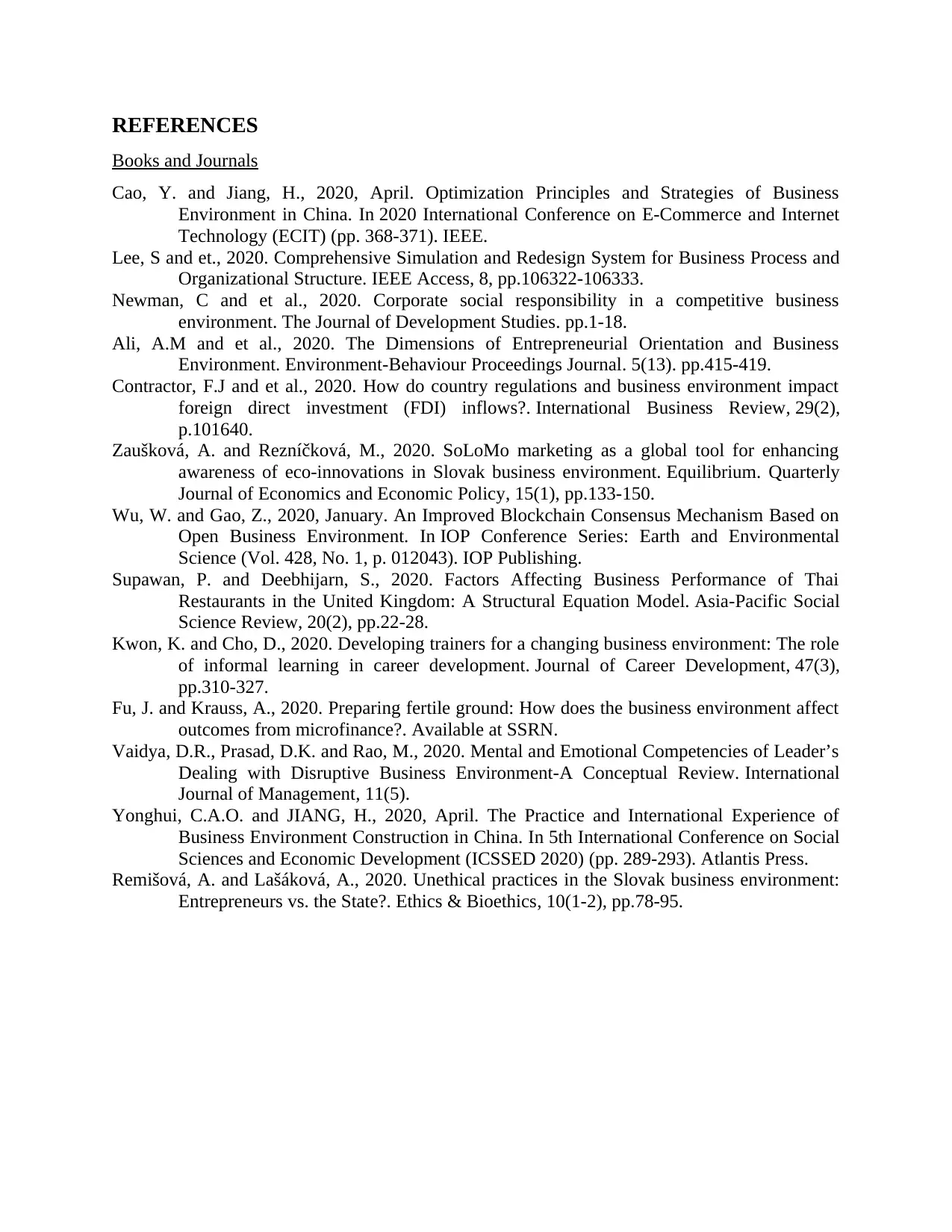
REFERENCES
Books and Journals
Cao, Y. and Jiang, H., 2020, April. Optimization Principles and Strategies of Business
Environment in China. In 2020 International Conference on E-Commerce and Internet
Technology (ECIT) (pp. 368-371). IEEE.
Lee, S and et., 2020. Comprehensive Simulation and Redesign System for Business Process and
Organizational Structure. IEEE Access, 8, pp.106322-106333.
Newman, C and et al., 2020. Corporate social responsibility in a competitive business
environment. The Journal of Development Studies. pp.1-18.
Ali, A.M and et al., 2020. The Dimensions of Entrepreneurial Orientation and Business
Environment. Environment-Behaviour Proceedings Journal. 5(13). pp.415-419.
Contractor, F.J and et al., 2020. How do country regulations and business environment impact
foreign direct investment (FDI) inflows?. International Business Review, 29(2),
p.101640.
Zaušková, A. and Rezníčková, M., 2020. SoLoMo marketing as a global tool for enhancing
awareness of eco-innovations in Slovak business environment. Equilibrium. Quarterly
Journal of Economics and Economic Policy, 15(1), pp.133-150.
Wu, W. and Gao, Z., 2020, January. An Improved Blockchain Consensus Mechanism Based on
Open Business Environment. In IOP Conference Series: Earth and Environmental
Science (Vol. 428, No. 1, p. 012043). IOP Publishing.
Supawan, P. and Deebhijarn, S., 2020. Factors Affecting Business Performance of Thai
Restaurants in the United Kingdom: A Structural Equation Model. Asia-Pacific Social
Science Review, 20(2), pp.22-28.
Kwon, K. and Cho, D., 2020. Developing trainers for a changing business environment: The role
of informal learning in career development. Journal of Career Development, 47(3),
pp.310-327.
Fu, J. and Krauss, A., 2020. Preparing fertile ground: How does the business environment affect
outcomes from microfinance?. Available at SSRN.
Vaidya, D.R., Prasad, D.K. and Rao, M., 2020. Mental and Emotional Competencies of Leader’s
Dealing with Disruptive Business Environment-A Conceptual Review. International
Journal of Management, 11(5).
Yonghui, C.A.O. and JIANG, H., 2020, April. The Practice and International Experience of
Business Environment Construction in China. In 5th International Conference on Social
Sciences and Economic Development (ICSSED 2020) (pp. 289-293). Atlantis Press.
Remišová, A. and Lašáková, A., 2020. Unethical practices in the Slovak business environment:
Entrepreneurs vs. the State?. Ethics & Bioethics, 10(1-2), pp.78-95.
Books and Journals
Cao, Y. and Jiang, H., 2020, April. Optimization Principles and Strategies of Business
Environment in China. In 2020 International Conference on E-Commerce and Internet
Technology (ECIT) (pp. 368-371). IEEE.
Lee, S and et., 2020. Comprehensive Simulation and Redesign System for Business Process and
Organizational Structure. IEEE Access, 8, pp.106322-106333.
Newman, C and et al., 2020. Corporate social responsibility in a competitive business
environment. The Journal of Development Studies. pp.1-18.
Ali, A.M and et al., 2020. The Dimensions of Entrepreneurial Orientation and Business
Environment. Environment-Behaviour Proceedings Journal. 5(13). pp.415-419.
Contractor, F.J and et al., 2020. How do country regulations and business environment impact
foreign direct investment (FDI) inflows?. International Business Review, 29(2),
p.101640.
Zaušková, A. and Rezníčková, M., 2020. SoLoMo marketing as a global tool for enhancing
awareness of eco-innovations in Slovak business environment. Equilibrium. Quarterly
Journal of Economics and Economic Policy, 15(1), pp.133-150.
Wu, W. and Gao, Z., 2020, January. An Improved Blockchain Consensus Mechanism Based on
Open Business Environment. In IOP Conference Series: Earth and Environmental
Science (Vol. 428, No. 1, p. 012043). IOP Publishing.
Supawan, P. and Deebhijarn, S., 2020. Factors Affecting Business Performance of Thai
Restaurants in the United Kingdom: A Structural Equation Model. Asia-Pacific Social
Science Review, 20(2), pp.22-28.
Kwon, K. and Cho, D., 2020. Developing trainers for a changing business environment: The role
of informal learning in career development. Journal of Career Development, 47(3),
pp.310-327.
Fu, J. and Krauss, A., 2020. Preparing fertile ground: How does the business environment affect
outcomes from microfinance?. Available at SSRN.
Vaidya, D.R., Prasad, D.K. and Rao, M., 2020. Mental and Emotional Competencies of Leader’s
Dealing with Disruptive Business Environment-A Conceptual Review. International
Journal of Management, 11(5).
Yonghui, C.A.O. and JIANG, H., 2020, April. The Practice and International Experience of
Business Environment Construction in China. In 5th International Conference on Social
Sciences and Economic Development (ICSSED 2020) (pp. 289-293). Atlantis Press.
Remišová, A. and Lašáková, A., 2020. Unethical practices in the Slovak business environment:
Entrepreneurs vs. the State?. Ethics & Bioethics, 10(1-2), pp.78-95.
1 out of 11
Related Documents
Your All-in-One AI-Powered Toolkit for Academic Success.
+13062052269
info@desklib.com
Available 24*7 on WhatsApp / Email
![[object Object]](/_next/static/media/star-bottom.7253800d.svg)
Unlock your academic potential
Copyright © 2020–2025 A2Z Services. All Rights Reserved. Developed and managed by ZUCOL.



